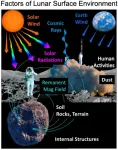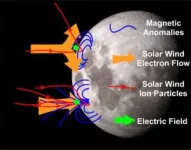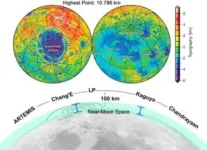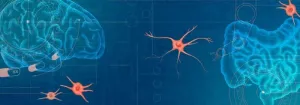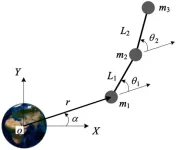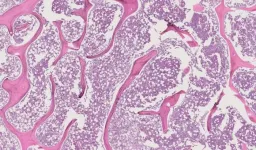As the nearest celestial body to Earth, Moon’s space environment is distinctive to Earth’s mainly because of lack of a significant atmosphere/ionosphere and a global magnetic field. From a global perspective, solar wind can bombard its surface, and the solar wind materials cumulated in the soil record the evolution of the Solar System. Many small-scale remanent magnetic fields are scattered over the lunar surface and, just as planetary magnetic fields protect planets, they are believed to divert the incident solar wind and shield the local lunar surface beneath, thus producing unique local surface environment that is critical to activities of human beings/facilities, thus providing unique landing sites to explore the origins of lunar swirls and remanent magnetic fields. Evidences have hinted that this local interaction, however, may be also distinct with the interacting scenario on planets, and the specific process has not been revealed because of lack of in situ observations in the near-Moon space or on the lunar surface. The global and local solar wind interactions of the Moon represent 2 types of characteristic interaction of celestial bodies with stellar wind in deep space, i.e., the interactions of nonmagnetized bodies and of small-scale magnetized bodies, both of which may occur on asteroids and Mars. These deep-space celestial bodies, either difficult or impossible to reach for human beings or artificial satellites, are hard to measure, and the exploration of the Moon can reveal the mystery of stellar wind interaction on these bodies. In a review article recently published in Space: Science & Technology, scholars from Chinese Academy of Sciences and Beihang University reviewed Key questions on solar wind–Moon interaction.
First, authors introduce the background environment and properties of the Moon (schemed in Fig. 1). The Sun continually releases energy into interplanetary space in two forms of ejecting particles and emitting radiations, which stirs up the space environment of the entire Solar System. The Sun ejects the magnetized plasma flow, which is solar wind composed of the oppositely charged particles, i.e., ions and electrons. The difference in mass between protons and electrons is huge, which makes the solar wind a complicated material with multiple scales. The solar wind interaction of the Moon consists of processes across multiple plasma scales, thus resulting in the complicated Moon’s space environment and solar wind interaction. The Sun also emits wide frequency-range radiations. About half of the solar radiation energy is confined within the visible waveband; however, the other radiations are key to the space environment around all kind of Solar System objects. The properties of the Moon itself also influence the solar wind interaction, and they are mainly the electrical conductivity and magnetism, where interdisciplinary studies between space physics, geophysics, and even geology are involved. As for internal structures, evidence shows that the Moon as a whole is not a good conductor. As for lunar magnetic fields, the Moon has been thought to have no global intrinsic magnetic field and, thus, have no lunar magnetosphere; but many small-scale remanent magnetic fields scattered over the lunar surface. As for the lunar atmosphere, a very thin atmosphere is present, and there is no a significant lunar ionosphere. As for the lunar surface, the interior of the Moon is covered the regolith layer, the outmost layer with a depth that can be as large as tens of kilometers. Lunar dust is another term frequently occurring when discussing the lunar surface environment, whose dynamics is controlled by the electric and magnetic fields.
Then, authors propose key questions of solar wind–moon interaction.
(1) Do the lunar mini-magnetospheres exist?
1.1. Do the mini-magnetosphere have the same structures as those of the huge planetary magnetosphere? In particular, does it have a bow shock ahead? Why?
1.2. How do the lunar magnetic anomalies affect the motion of the solar wind electrons and ions inside and outside of the local magnetic structures? And how do these influences (waves and particles) propagate in the space outside of the anomalies?
1.3. How do the lunar swirls form? Do they form because of different solar wind implantation or because of local immigration of fine soil grains? Why there is not one to one correspondence between the lunar swirls and the magnetic anomalies?
1.4. Is the granularity of the lunar soil grains abnormal under the magnetic anomalies compared with those on the surface without remanent magnetic field?
1.5. What is the difference in cumulation of solar wind materials and water (hydroxyl) in the lunar surface soil? What is the relation of this difference to the geometry or magnitude of magnetic fields near the lunar surface?
(2) How do the nonconductive lunar regolith layer and the purely conductive solar wind couple at the lunar surface boundary?
2.1. How do the key physical parameters, including the distribution functions of electrons (from solar wind or photoelectrons), ions (from solar wind or scattered/reflected ions) and neutrals (spattered from the lunar surface), and the electric field and the magnetic field, vary with altitudes in the near-Moon space, solar zenith angles, and solar conditions (solar wind and solar EUV radiations)?
2.2. Is there a boundary layer above the unmagnetized lunar surface where kinetic plasma physics dominates and IMFs are slightly piled-up?
2.3. How are the lunar soil grains ejected from the lunar surface to be dusts in space?
2.4. Is there any evidence of local transport of lunar grains within a region with complicated terrains?
2.5. How do the lunar dusts reach altitudes as large as several hundreds of kilometers?
2.6. Why have not the finest grains in the surface soil been exhausted during the long evolution history of the Moon? After all, the lunar dust is not a very rare phenomenon, indicating that there are always fine grains on the lunar surface. What is the endless source of these finest grains? Is there any circulation process of these finest soil grains between the nearby space and the ground?
(3) Do we really know the magnetic field of the Moon itself?
3.1. Is there a weak global intrinsic magnetic field on the Moon?
3.2. Is there any local induced magnetic field on the lunar surface?
3.3. How can we obtain a real map of magnetic fields of the Moon itself?
3.4. How many types of origin do the lunar magnetic anomalies have?
3.5. Is there any special distribution pattern of the magnetic anomalies that formed in similar geological ages, in terms of strength or direction of their magnetic momenta?
3.6. How to determine the formation ages of the lunar magnetic anomalies?
To answer these questions, the extensive measurements in the near-Moon space and on the ground are necessary.
Finally, authors review previous lunar missions and put up concepts of future lunar exploration missions. Although high-quality instruments have been equipped onboard the modern satellite missions, the detail space physical structures/processes have not been fully understood because most satellites do not tend to descend to such altitudes as low as 30 km to avoid impacting on lunar surface or lunar mountains (Fig. 3). Authors create a new term “near-Moon space” to refer to the space surrounding the Moon with heights below 30 km. In future, the near-Moon space and the lunar ground will be the hot target regions for lunar space missions. Extensive space physics and geology exploration done by low-altitude lunar orbiters in the near-Moon space or done by manned or unmanned lunar rovers along long-distance traces on the lunar surface are desired, which can give answers to the key questions mentioned above. The surface of magnetic anomaly is the most valuable candidate landing site, where the interdisciplinary studies can be performed among space physics, geophysics, and geology on the subjects such as the origin of lunar swirls, the origin of remanent magnetic fields (magnetic anomalies), and the mechanism of lifting of lunar dust, finding evidence for evolution of Solar System and even finding suitable place for human habitation.
Reference
Article Title: Key Questions of Solar Wind–Moon Interaction
Corresponding Author Information: HUI ZHANG, JINBIN CAO* , YANGTING LIN, YONG WEI, LEI LI, XIANGUO ZHANG, HONGLEI LIN, AND LIANGHAI XIE
Author Affiliations: School of Space and Environment, Beihang University, Beijing 100191, China.
Link to the Article: https://spj.science.org/doi/10.34133/space.0060
END
